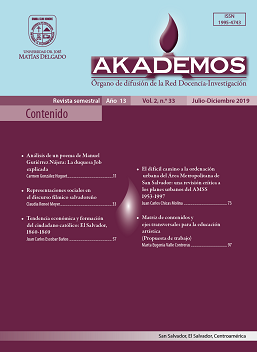The difficult path to ordination of the Metropolitan Area of San Salvador: a critical review of AMSS urban plans 1953-1997
DOI:
https://doi.org/10.5377/akademos.v0i0.9511Keywords:
Metropolitan Area, San Salvador, Urban Development, Environment, Urban Densification, Housing, Open Spaces, Urban Structure, green areasAbstract
Three of the main urban plans elaborated for the Metropolitan Area of San Salvador (AMSS) are analyzed, identifying those component elements that formed the Salvadoran metropolis. It begins with the proposal of 1953, where the structuring of the city was proposed by an articulated system of neighborhood centers interconnected by a modern road system. Next, METROPLAN 80 (1968) is examined, which addressed the structuring of the city from an economic vision prevailing in the era of strong state planning. Finally, the PLAMADUR-AMSSA (1996) plan is reviewed, which proposed a redensification of the central core of the city, with a view to a compact city. It is concluded that the urban management path of the AMSS has followed the dynamics as well as most of the cities in the region, marked by the economic, social and environmental peculiarities of their own.
Downloads
1184

